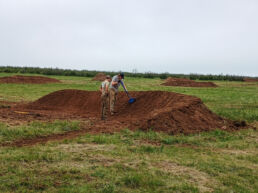We’ve got Dr Brad Abrahamson of Integrative Sports Medicine on deck to discuss the diagnosis of bursitis
If you have a sports injury related question, contact Dr Brad directly via his Facebook page, website or email YGR and we’ll get it forwarded on to him.
This article addresses bursitis and also delves into how Integrative Medicine and Functional Medicine help get from a superficial look at a problem to the underlying diagnosis, which can inform better treatment plans.
A bursa is a friction-reducing structure between two things in the body that move. It is a “potential space,” like a water balloon with just a tiny amount of lubrication inside so that whatever is attached to one side can freely glide against whatever is attached to the other side. I’ll give two examples. First, the subacromial bursa. This sits between the rotator cuff and the acromion bone at the top of the inside of the shoulder. It allows the rotator cuff, which moves a great deal, to glide by overlying structures such as the acromion bone, the end of the collarbone (clavicle) and the deltoid muscle, do not move much compared with the rotator cuff tendons.

A good second example would be any of the bursae around the greater trochanter, which collectively are called the “trochanteric bursa.” These bursae allow movement of the muscles overlying the greater trochanter against themselves and against the bone. The tensor fascia lata has to glide against the iliotibial band and all the muscles have to be able to glide over the greater trochanter. The trochanteric bursitis allows this by greatly reducing the friction.
All bursae are subject to becoming inflamed, and typical medical advice includes icing, taking NSAIDs, and sometimes progression to corticosteroid injection and even surgical bursectomy.
My take is that all these therapies miss the point. They miss it because they assume that bursitis is the entity. To the contrary, bursitis is a side-effect. To get a diagnosis that can lead to a cure rather than a band-aid approach, integrative and functional medicine need to be employed.
Functional Medicine as the Basis of Diagnosis and Integrative Medicine as a System of Treatment
If you are reading this, I am guessing that you have a sense that there is something terribly wrong with how traditional medicine is being presented to you. You are right. It is not just the money machine, not just “Big Pharma” and not just the unreasonable time pressure your doctor faces. Traditional medicine is at times fundamentally flawed by cognitive errors which are sometimes intertwined with the system errors within medical bureaucracy. There are many cognitive errors in medicine (see http://www.jround.co.uk/error/reading/crosskerry1.pdf). Functional medicine is a step towards correcting some of these cognitive errors that lead to superficial or spurious diagnoses.
Functional medicine looks for underlying causes in a serious way. It’s not just “you contracted bursitis from overuse.” It is more like, “you contracted bursitis because the adjacent tendon/muscle use is under chronic strain due to an adverse biomechanical pattern, under-recovery, sub-optimal nutrition and other specific factors.” This gets to why bursitis should not just be squelched by a steroid injection, but the underlying reasons it happened in the first place should be addressed. Here is an example of how functional thinking might occur in a certain patient with a subacromial bursitis.
-
The patient has gotten “out of shape,” leaving the tendons adjacent to the bursa unhealthy.
-
The person got “out of shape” because of work and life stressors that reached a breaking point, leading to the patient taking less time to rest, sleep and exercise;
-
Because of time pressure and a shift of priorities from good health to making deadlines, good nutrition such as an exuberant intake of vegetables and a control on calorie intake went by the wayside.
-
Because of the inadequate intake of micronutrients and rest, tendons are not able to heal from day to day.
-
Because the tendons are under stress, the patient takes NSAIDs (non-steroidal anti-inflammatory medications) to deal with the pain. The NSAIDs compound the problem by blocking an “inflammatory” pathway in connective tissue healing that prolongs the healing time.
-
Because the patient realizes they are “out of shape” they start exercising, but not with good form and beyond their current ability level, thinking about an earlier era in their life when certain effort and repetitions did not lead to problems. They do military overhead presses which stress the rotator cuff tendons and mechanically damage them by impinging on the acromion bone.
-
Because of the impingement, under-nutrition and under-recovery, the rotator cuff tendons begin to develop micro-tearing.
-
Because of the micro-tearing, the rotator cuff tendons develop micro-tearing of their collagen sub-units, the collagen fibrils. If I am lucky enough to see the patient at that point, I can see these small injuries on in-office diagnostic ultrasound and address the problem before it progresses to a rotator cuff tear.
-
Because tendon micro-tears don’t hurt badly at first, all of the above processes continue unabated.
-
Because the patient is un-aware of an impending problem, they continue to do military overhead presses unabated, and the impingement problem is ever worsening due to the progressively bad biomechanics that results from a sub-optimal rotator cuff.
-
Eventually micro-tears of the rotator cuff release enough inflammatory mediators that the sub-acromial bursa becomes inflamed. In addition, by this point, there is likely a partial tear of the rotator cuff.
At this point, most clinicians are trained and time-pressured to identify and “treat” the bursitis. They are using System 1 thinking, the immediate, emotional response of what seems right (see http://bigthink.com/errors-we-live-by/kahnemans-mind-clarifying-biases for a quick look at that). Then the doctor might jump right to “inject the bursa with steroid” (unintentionally by often harmful) and move on with the day. In contrast, the Functional approach is to consider all 11 (and more) of the above factors causing the bursitis and deal with each one. This is System 2 thinking.
As you can see, bursitis is not a self-explaining entity, and is not a satisfying diagnosis that can be treated with corticosteroids or surgery. Corticosteroids mask the underlying problems and shut down healing processes. Surgery removes an essential structure. This is where functional and integrative sports medicine comes in. Now, we can think about biomechanical causes while we watch the patient walk or run. We can find out if they need nutritional help, and we can find out what type of physical therapy will help solve the underlying problems. Sometimes, as in the last case of the youth pitcher, all we needed to do was link the existing coaching information for the patient into a single pitch, and the stress on the painful joint is relieved. Occasionally biologic and cutting-edge therapies may have a role. Integrative medicine takes a multi-disciplinary approach, for a more permanent and natural solution.
To summarize, a functional approach assesses the patient as a whole, adds up the underlying causes, and refuses to accept the presenting symptom as the entire picture. It leads to a diagnosis that is more holistic and more specific. The integrative approach then utilizes a number of treatment approaches to get a much more comprehensive set of treatment options. Integrative sports medicine asserts a true team approach, where the team synergistically employs the available skills, techniques and treatments, utilizing any or all parts of my skill-set, and most importantly any and all of the therapeutic community.
Bradley S. Abrahamson, MD is a Fellowship Trained Sports Medicine physician with a long-standing interest in bone and joint health. His focus is on helping patients reach their individualized, specific activity goals, whether by restoring knees, hips, shoulders, elbows and all extremity structures.
This can start with biomechanical analysis such as gait or throwing analysis, diagnostic ultrasound and physical exam and an accurate history and assessment of individual goals. X-ray and/or MRI is ordered and read personally by Dr. Abrahamson when needed.
He also uses innovative methods to clear the inflammation out of a joint and to restore the lining of the joint, the synovium, to a more healthy state. He also has Tenex techniques to clean out unhealthy tendon, leaving behind healthy cells and tissues for healing. He has a unique skill in diagnostic ultrasound including musculoskeletal ultrasound and peripheral nerve entrapment syndromes which often mimic joint pain. In addition to doing various ultrasound-guided procedures, he is certified by the American Association of Physicists in Medicine to do fluoroscopy, an x-ray based guidance system that also improves patient safety in procedures.
Dr. Abrahamson constantly studies sports and musculoskeletal medicine, cell science and biochemical topics related to joint health and performance. His education includes an Internship in General Surgery, 3 years of Orthopaedic Surgery, 3 years of Family Medicine and the Residency in Sports Medicine adds a Certification of Added Qualification in Sports Medicine to his Board Certification in Family Medicine.
Dr. Abrahamson grew up primarily in Colorado but graduated from Medical School with Honors including a Distinction in Research at SUNY-Stony Brook, a well-known medical school on the East Coast. He was named the “Most Outstanding Clinician” for the Class of 1999. He did his General Surgery and the 3 years of Orthopaedic Surgery at the University of North Carolina at Chapel Hill before changing his focus to Sports Medicine.
Dr. Abrahamson lives in Fort Collins with his wife Lara, who is a Family Physician, and his two children.
Publications include a book “Inside Injury Diagnosis” and his next book is in process.






